Evaluation and Monitoring of Business Practices and Policies
VerifiedAdded on 2021/05/31
|6
|1390
|137
Report
AI Summary
This report, divided into two parts, explores the significance of evaluation and monitoring in business practices. Part A emphasizes how organizations use evaluation and monitoring to identify areas for improvement, adapt to market situations, and manage risks, referencing various studies to support these points. It highlights the role of monitoring in enhancing productivity and adapting to market changes. Part B focuses on Cambodia's tourism industry, detailing how government policies have boosted trade and socio-economic gains. It examines the impact of these policies on tourism, trade, and the preservation of natural resources, concluding with recommendations for future actions. The report underscores the importance of strategic planning, sustainable development, and the adaptation of policies to meet evolving needs.
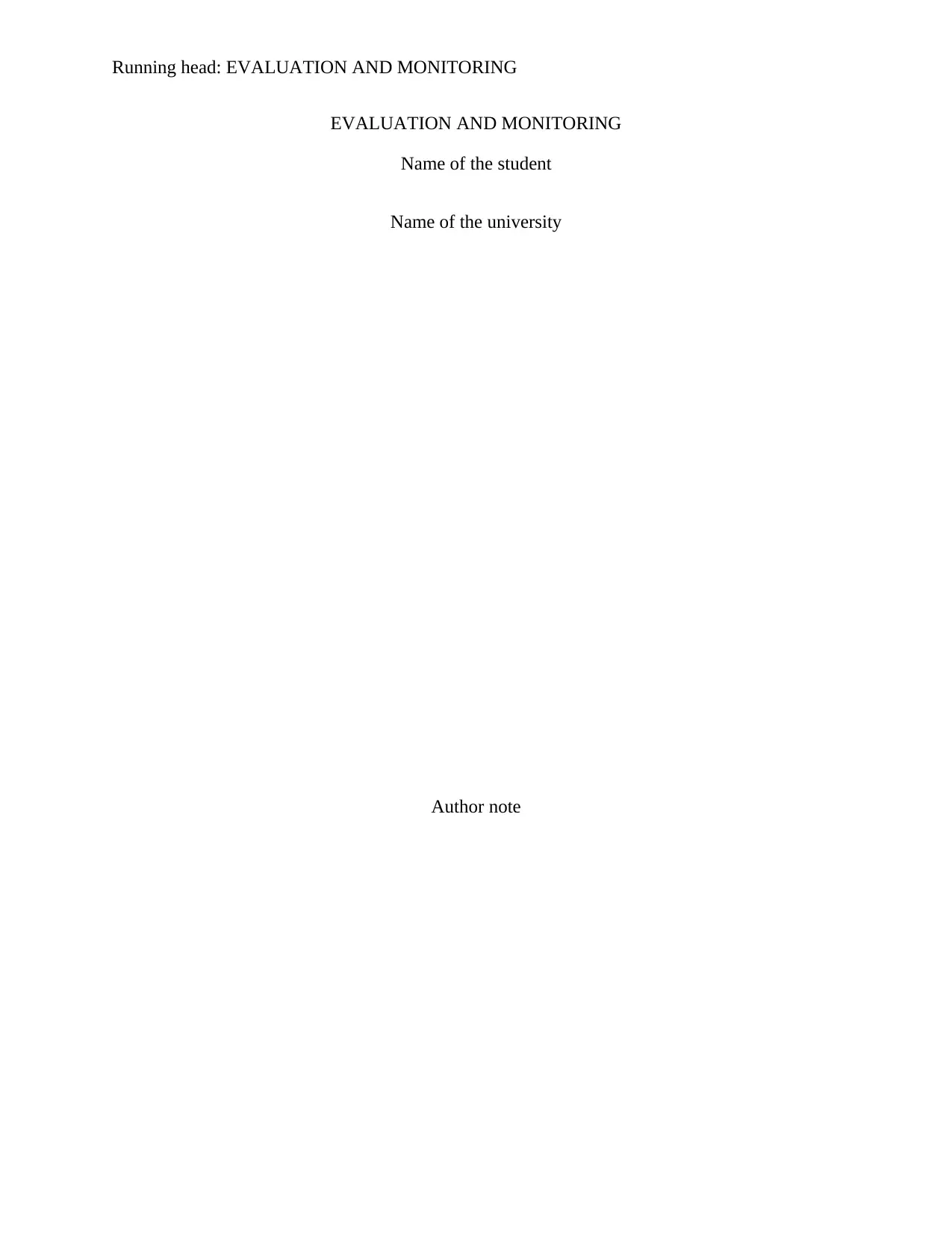
Running head: EVALUATION AND MONITORING
EVALUATION AND MONITORING
Name of the student
Name of the university
Author note
EVALUATION AND MONITORING
Name of the student
Name of the university
Author note
Paraphrase This Document
Need a fresh take? Get an instant paraphrase of this document with our AI Paraphraser
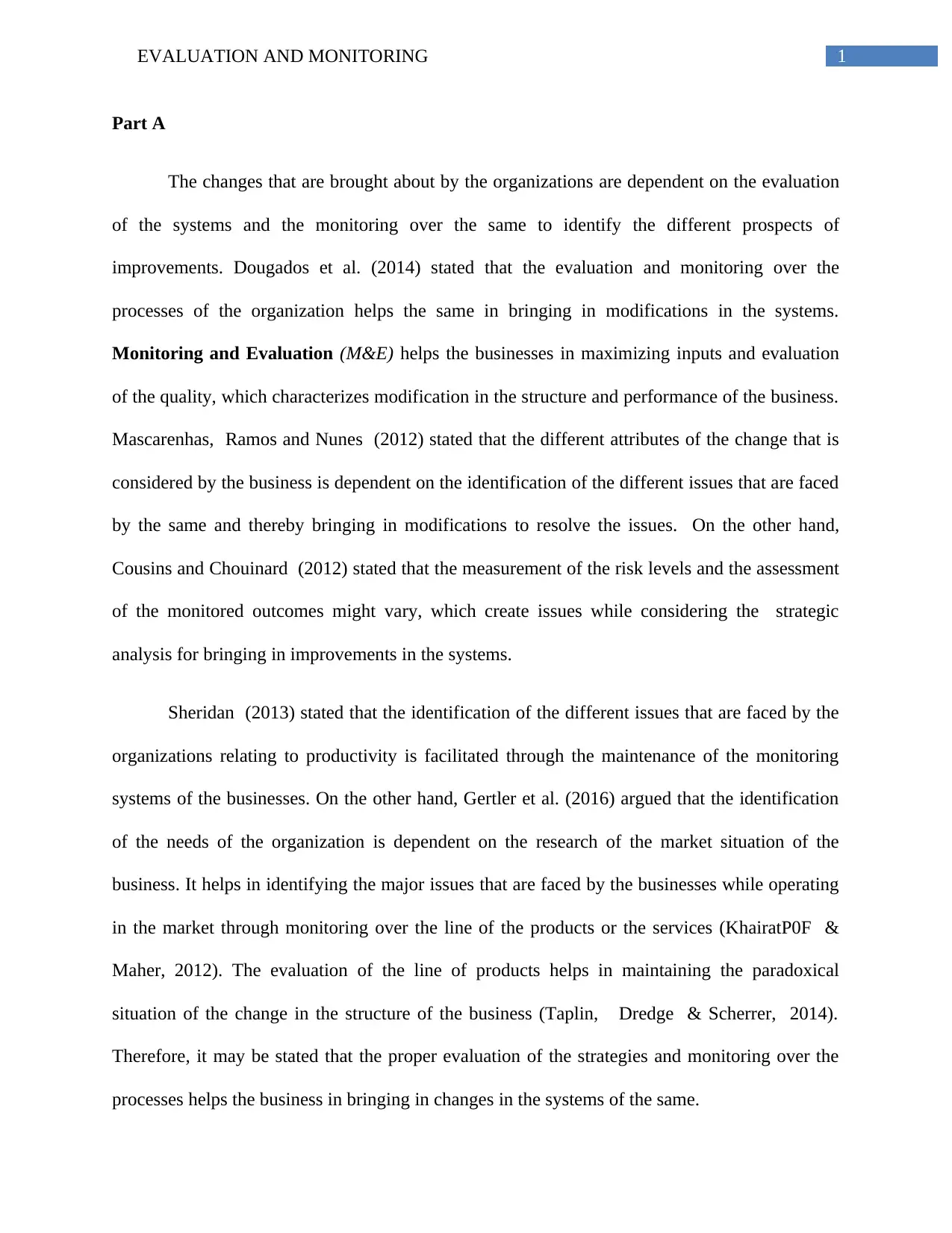
1EVALUATION AND MONITORING
Part A
The changes that are brought about by the organizations are dependent on the evaluation
of the systems and the monitoring over the same to identify the different prospects of
improvements. Dougados et al. (2014) stated that the evaluation and monitoring over the
processes of the organization helps the same in bringing in modifications in the systems.
Monitoring and Evaluation (M&E) helps the businesses in maximizing inputs and evaluation
of the quality, which characterizes modification in the structure and performance of the business.
Mascarenhas, Ramos and Nunes (2012) stated that the different attributes of the change that is
considered by the business is dependent on the identification of the different issues that are faced
by the same and thereby bringing in modifications to resolve the issues. On the other hand,
Cousins and Chouinard (2012) stated that the measurement of the risk levels and the assessment
of the monitored outcomes might vary, which create issues while considering the strategic
analysis for bringing in improvements in the systems.
Sheridan (2013) stated that the identification of the different issues that are faced by the
organizations relating to productivity is facilitated through the maintenance of the monitoring
systems of the businesses. On the other hand, Gertler et al. (2016) argued that the identification
of the needs of the organization is dependent on the research of the market situation of the
business. It helps in identifying the major issues that are faced by the businesses while operating
in the market through monitoring over the line of the products or the services (KhairatP0F &
Maher, 2012). The evaluation of the line of products helps in maintaining the paradoxical
situation of the change in the structure of the business (Taplin, Dredge & Scherrer, 2014).
Therefore, it may be stated that the proper evaluation of the strategies and monitoring over the
processes helps the business in bringing in changes in the systems of the same.
Part A
The changes that are brought about by the organizations are dependent on the evaluation
of the systems and the monitoring over the same to identify the different prospects of
improvements. Dougados et al. (2014) stated that the evaluation and monitoring over the
processes of the organization helps the same in bringing in modifications in the systems.
Monitoring and Evaluation (M&E) helps the businesses in maximizing inputs and evaluation
of the quality, which characterizes modification in the structure and performance of the business.
Mascarenhas, Ramos and Nunes (2012) stated that the different attributes of the change that is
considered by the business is dependent on the identification of the different issues that are faced
by the same and thereby bringing in modifications to resolve the issues. On the other hand,
Cousins and Chouinard (2012) stated that the measurement of the risk levels and the assessment
of the monitored outcomes might vary, which create issues while considering the strategic
analysis for bringing in improvements in the systems.
Sheridan (2013) stated that the identification of the different issues that are faced by the
organizations relating to productivity is facilitated through the maintenance of the monitoring
systems of the businesses. On the other hand, Gertler et al. (2016) argued that the identification
of the needs of the organization is dependent on the research of the market situation of the
business. It helps in identifying the major issues that are faced by the businesses while operating
in the market through monitoring over the line of the products or the services (KhairatP0F &
Maher, 2012). The evaluation of the line of products helps in maintaining the paradoxical
situation of the change in the structure of the business (Taplin, Dredge & Scherrer, 2014).
Therefore, it may be stated that the proper evaluation of the strategies and monitoring over the
processes helps the business in bringing in changes in the systems of the same.
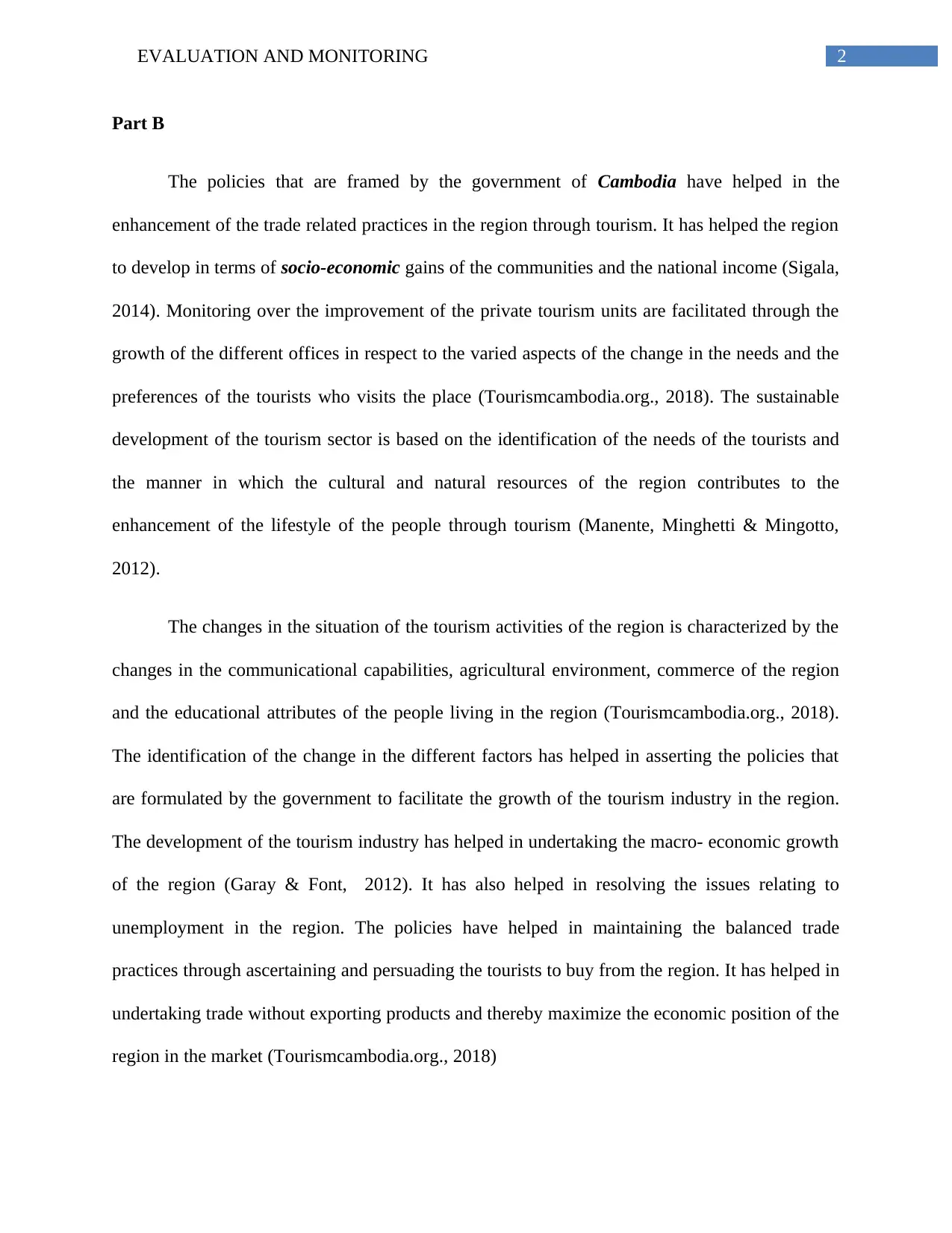
2EVALUATION AND MONITORING
Part B
The policies that are framed by the government of Cambodia have helped in the
enhancement of the trade related practices in the region through tourism. It has helped the region
to develop in terms of socio-economic gains of the communities and the national income (Sigala,
2014). Monitoring over the improvement of the private tourism units are facilitated through the
growth of the different offices in respect to the varied aspects of the change in the needs and the
preferences of the tourists who visits the place (Tourismcambodia.org., 2018). The sustainable
development of the tourism sector is based on the identification of the needs of the tourists and
the manner in which the cultural and natural resources of the region contributes to the
enhancement of the lifestyle of the people through tourism (Manente, Minghetti & Mingotto,
2012).
The changes in the situation of the tourism activities of the region is characterized by the
changes in the communicational capabilities, agricultural environment, commerce of the region
and the educational attributes of the people living in the region (Tourismcambodia.org., 2018).
The identification of the change in the different factors has helped in asserting the policies that
are formulated by the government to facilitate the growth of the tourism industry in the region.
The development of the tourism industry has helped in undertaking the macro- economic growth
of the region (Garay & Font, 2012). It has also helped in resolving the issues relating to
unemployment in the region. The policies have helped in maintaining the balanced trade
practices through ascertaining and persuading the tourists to buy from the region. It has helped in
undertaking trade without exporting products and thereby maximize the economic position of the
region in the market (Tourismcambodia.org., 2018)
Part B
The policies that are framed by the government of Cambodia have helped in the
enhancement of the trade related practices in the region through tourism. It has helped the region
to develop in terms of socio-economic gains of the communities and the national income (Sigala,
2014). Monitoring over the improvement of the private tourism units are facilitated through the
growth of the different offices in respect to the varied aspects of the change in the needs and the
preferences of the tourists who visits the place (Tourismcambodia.org., 2018). The sustainable
development of the tourism sector is based on the identification of the needs of the tourists and
the manner in which the cultural and natural resources of the region contributes to the
enhancement of the lifestyle of the people through tourism (Manente, Minghetti & Mingotto,
2012).
The changes in the situation of the tourism activities of the region is characterized by the
changes in the communicational capabilities, agricultural environment, commerce of the region
and the educational attributes of the people living in the region (Tourismcambodia.org., 2018).
The identification of the change in the different factors has helped in asserting the policies that
are formulated by the government to facilitate the growth of the tourism industry in the region.
The development of the tourism industry has helped in undertaking the macro- economic growth
of the region (Garay & Font, 2012). It has also helped in resolving the issues relating to
unemployment in the region. The policies have helped in maintaining the balanced trade
practices through ascertaining and persuading the tourists to buy from the region. It has helped in
undertaking trade without exporting products and thereby maximize the economic position of the
region in the market (Tourismcambodia.org., 2018)
⊘ This is a preview!⊘
Do you want full access?
Subscribe today to unlock all pages.

Trusted by 1+ million students worldwide
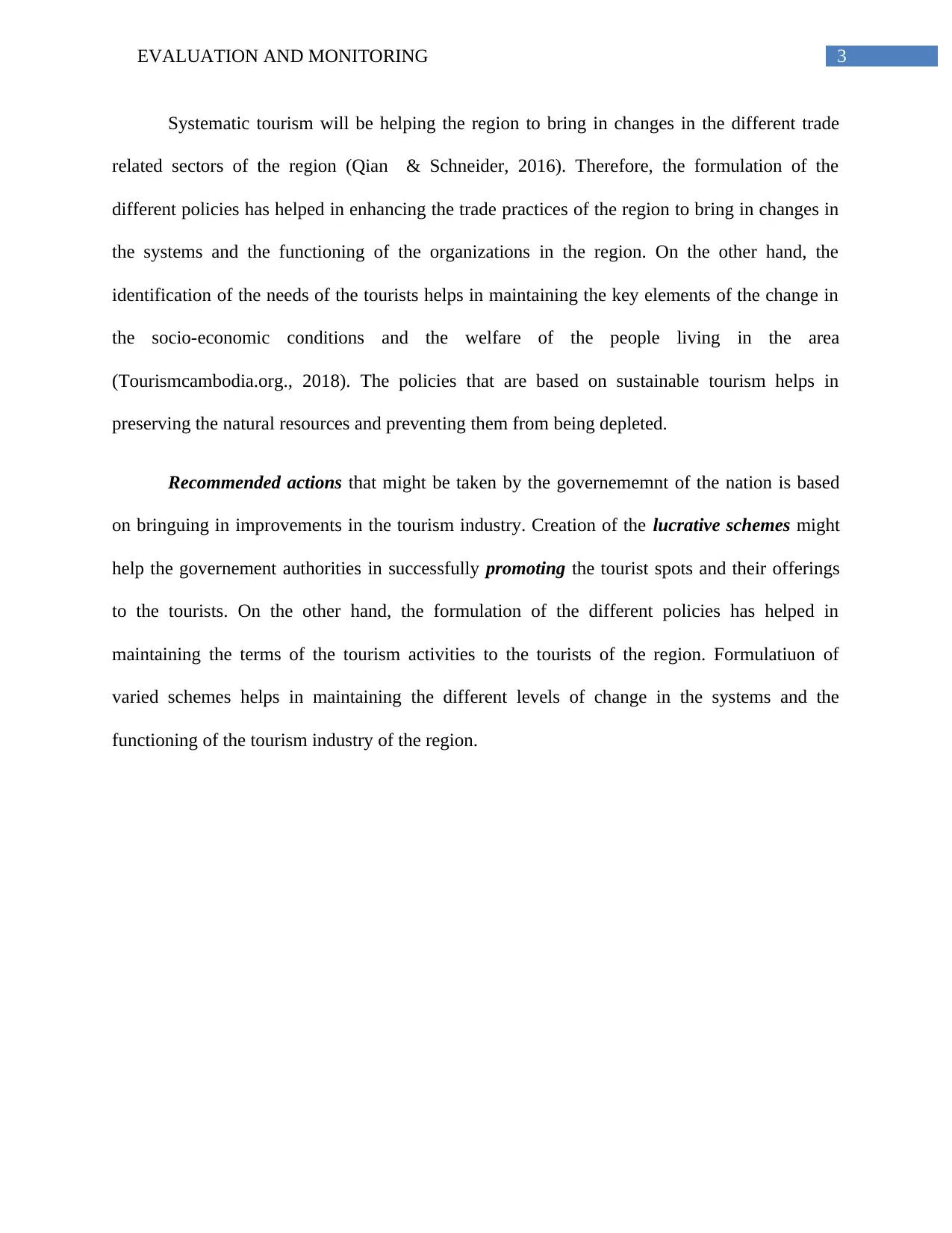
3EVALUATION AND MONITORING
Systematic tourism will be helping the region to bring in changes in the different trade
related sectors of the region (Qian & Schneider, 2016). Therefore, the formulation of the
different policies has helped in enhancing the trade practices of the region to bring in changes in
the systems and the functioning of the organizations in the region. On the other hand, the
identification of the needs of the tourists helps in maintaining the key elements of the change in
the socio-economic conditions and the welfare of the people living in the area
(Tourismcambodia.org., 2018). The policies that are based on sustainable tourism helps in
preserving the natural resources and preventing them from being depleted.
Recommended actions that might be taken by the governememnt of the nation is based
on bringuing in improvements in the tourism industry. Creation of the lucrative schemes might
help the governement authorities in successfully promoting the tourist spots and their offerings
to the tourists. On the other hand, the formulation of the different policies has helped in
maintaining the terms of the tourism activities to the tourists of the region. Formulatiuon of
varied schemes helps in maintaining the different levels of change in the systems and the
functioning of the tourism industry of the region.
Systematic tourism will be helping the region to bring in changes in the different trade
related sectors of the region (Qian & Schneider, 2016). Therefore, the formulation of the
different policies has helped in enhancing the trade practices of the region to bring in changes in
the systems and the functioning of the organizations in the region. On the other hand, the
identification of the needs of the tourists helps in maintaining the key elements of the change in
the socio-economic conditions and the welfare of the people living in the area
(Tourismcambodia.org., 2018). The policies that are based on sustainable tourism helps in
preserving the natural resources and preventing them from being depleted.
Recommended actions that might be taken by the governememnt of the nation is based
on bringuing in improvements in the tourism industry. Creation of the lucrative schemes might
help the governement authorities in successfully promoting the tourist spots and their offerings
to the tourists. On the other hand, the formulation of the different policies has helped in
maintaining the terms of the tourism activities to the tourists of the region. Formulatiuon of
varied schemes helps in maintaining the different levels of change in the systems and the
functioning of the tourism industry of the region.
Paraphrase This Document
Need a fresh take? Get an instant paraphrase of this document with our AI Paraphraser
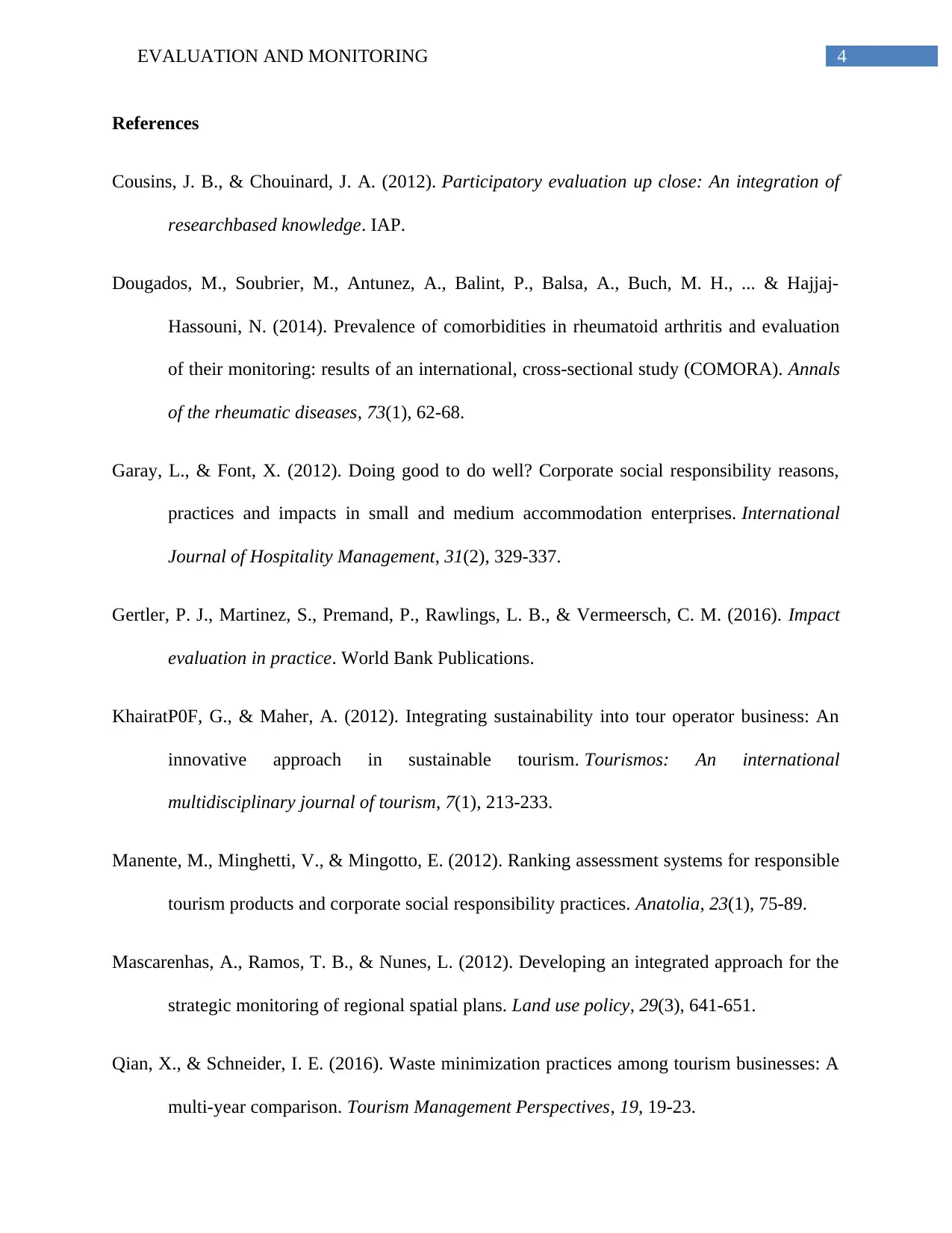
4EVALUATION AND MONITORING
References
Cousins, J. B., & Chouinard, J. A. (2012). Participatory evaluation up close: An integration of
researchbased knowledge. IAP.
Dougados, M., Soubrier, M., Antunez, A., Balint, P., Balsa, A., Buch, M. H., ... & Hajjaj-
Hassouni, N. (2014). Prevalence of comorbidities in rheumatoid arthritis and evaluation
of their monitoring: results of an international, cross-sectional study (COMORA). Annals
of the rheumatic diseases, 73(1), 62-68.
Garay, L., & Font, X. (2012). Doing good to do well? Corporate social responsibility reasons,
practices and impacts in small and medium accommodation enterprises. International
Journal of Hospitality Management, 31(2), 329-337.
Gertler, P. J., Martinez, S., Premand, P., Rawlings, L. B., & Vermeersch, C. M. (2016). Impact
evaluation in practice. World Bank Publications.
KhairatP0F, G., & Maher, A. (2012). Integrating sustainability into tour operator business: An
innovative approach in sustainable tourism. Tourismos: An international
multidisciplinary journal of tourism, 7(1), 213-233.
Manente, M., Minghetti, V., & Mingotto, E. (2012). Ranking assessment systems for responsible
tourism products and corporate social responsibility practices. Anatolia, 23(1), 75-89.
Mascarenhas, A., Ramos, T. B., & Nunes, L. (2012). Developing an integrated approach for the
strategic monitoring of regional spatial plans. Land use policy, 29(3), 641-651.
Qian, X., & Schneider, I. E. (2016). Waste minimization practices among tourism businesses: A
multi-year comparison. Tourism Management Perspectives, 19, 19-23.
References
Cousins, J. B., & Chouinard, J. A. (2012). Participatory evaluation up close: An integration of
researchbased knowledge. IAP.
Dougados, M., Soubrier, M., Antunez, A., Balint, P., Balsa, A., Buch, M. H., ... & Hajjaj-
Hassouni, N. (2014). Prevalence of comorbidities in rheumatoid arthritis and evaluation
of their monitoring: results of an international, cross-sectional study (COMORA). Annals
of the rheumatic diseases, 73(1), 62-68.
Garay, L., & Font, X. (2012). Doing good to do well? Corporate social responsibility reasons,
practices and impacts in small and medium accommodation enterprises. International
Journal of Hospitality Management, 31(2), 329-337.
Gertler, P. J., Martinez, S., Premand, P., Rawlings, L. B., & Vermeersch, C. M. (2016). Impact
evaluation in practice. World Bank Publications.
KhairatP0F, G., & Maher, A. (2012). Integrating sustainability into tour operator business: An
innovative approach in sustainable tourism. Tourismos: An international
multidisciplinary journal of tourism, 7(1), 213-233.
Manente, M., Minghetti, V., & Mingotto, E. (2012). Ranking assessment systems for responsible
tourism products and corporate social responsibility practices. Anatolia, 23(1), 75-89.
Mascarenhas, A., Ramos, T. B., & Nunes, L. (2012). Developing an integrated approach for the
strategic monitoring of regional spatial plans. Land use policy, 29(3), 641-651.
Qian, X., & Schneider, I. E. (2016). Waste minimization practices among tourism businesses: A
multi-year comparison. Tourism Management Perspectives, 19, 19-23.
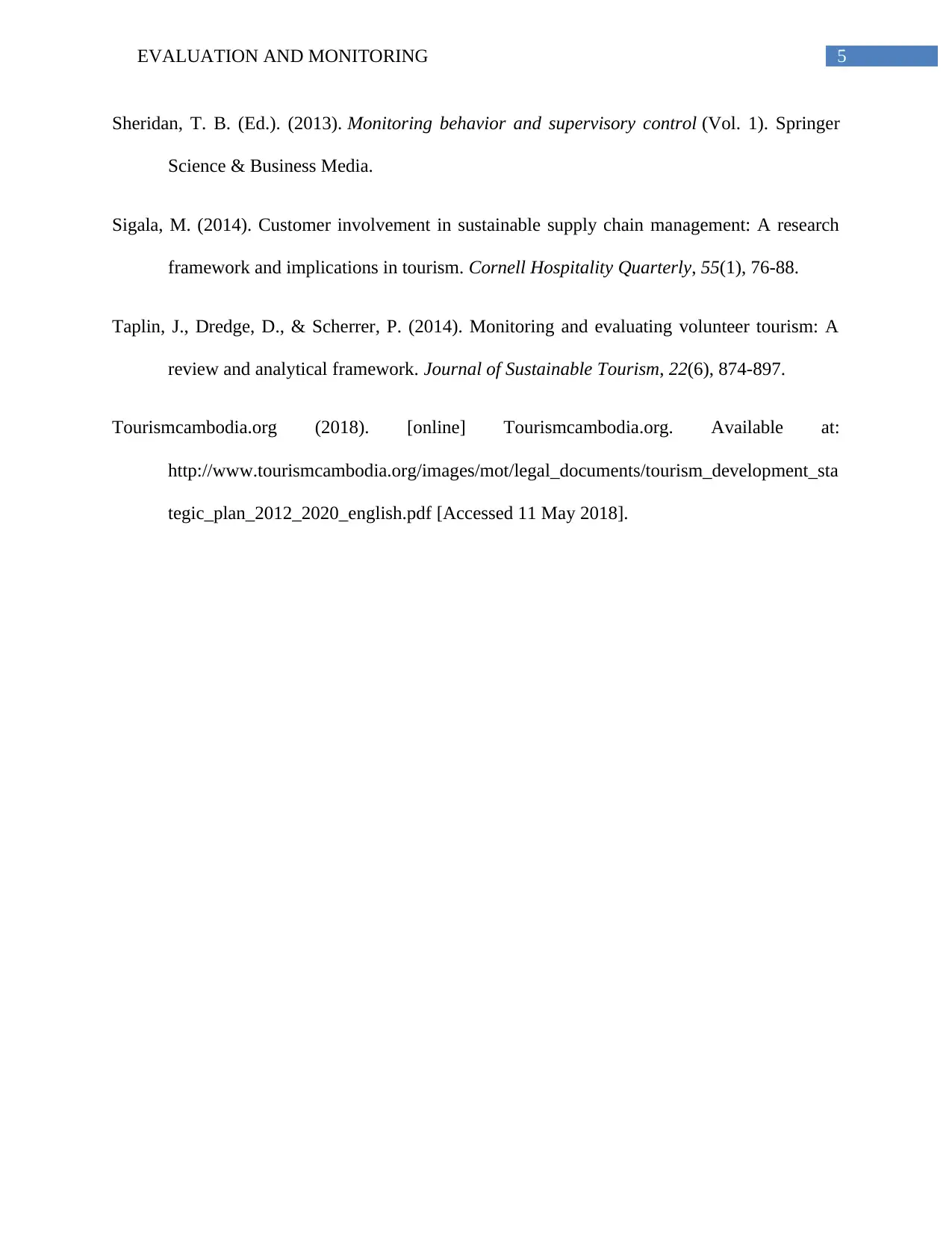
5EVALUATION AND MONITORING
Sheridan, T. B. (Ed.). (2013). Monitoring behavior and supervisory control (Vol. 1). Springer
Science & Business Media.
Sigala, M. (2014). Customer involvement in sustainable supply chain management: A research
framework and implications in tourism. Cornell Hospitality Quarterly, 55(1), 76-88.
Taplin, J., Dredge, D., & Scherrer, P. (2014). Monitoring and evaluating volunteer tourism: A
review and analytical framework. Journal of Sustainable Tourism, 22(6), 874-897.
Tourismcambodia.org (2018). [online] Tourismcambodia.org. Available at:
http://www.tourismcambodia.org/images/mot/legal_documents/tourism_development_sta
tegic_plan_2012_2020_english.pdf [Accessed 11 May 2018].
Sheridan, T. B. (Ed.). (2013). Monitoring behavior and supervisory control (Vol. 1). Springer
Science & Business Media.
Sigala, M. (2014). Customer involvement in sustainable supply chain management: A research
framework and implications in tourism. Cornell Hospitality Quarterly, 55(1), 76-88.
Taplin, J., Dredge, D., & Scherrer, P. (2014). Monitoring and evaluating volunteer tourism: A
review and analytical framework. Journal of Sustainable Tourism, 22(6), 874-897.
Tourismcambodia.org (2018). [online] Tourismcambodia.org. Available at:
http://www.tourismcambodia.org/images/mot/legal_documents/tourism_development_sta
tegic_plan_2012_2020_english.pdf [Accessed 11 May 2018].
⊘ This is a preview!⊘
Do you want full access?
Subscribe today to unlock all pages.

Trusted by 1+ million students worldwide
1 out of 6
Related Documents
Your All-in-One AI-Powered Toolkit for Academic Success.
+13062052269
info@desklib.com
Available 24*7 on WhatsApp / Email
![[object Object]](/_next/static/media/star-bottom.7253800d.svg)
Unlock your academic potential
Copyright © 2020–2025 A2Z Services. All Rights Reserved. Developed and managed by ZUCOL.





